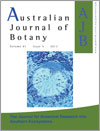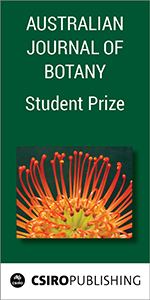Eucalypts are some of the world’s most successful resprouting trees after medium- to high-intensity fires. In particular, their ability to resprout from the stems and branches (epicormic resprouting) after fire is particularly pronounced and would appear to provide certain ecological advantages over plants that can only resprout from the base. This review shows that the eucalypts possess a range of bud-forming structures that are apparently adapted to resprouting after fire rather than other disturbances, such as storms and drought.

Australian Journal of Botany
Volume 61 Number 5 2013
BT12236Specific leaf area: a predictive model using dried samples
Specific leaf area (SLA; fresh-leaf area/dry mass) describes the amount of leaf area for light capture per unit of biomass invested. Because the standard protocol for quantifying SLA requires recently collected sun-exposed leaves to determine fresh-leaf area, it limits where and which samples can be studied. A protocol to predict SLA from herbarium-dried leaves was developed from samples collected in a dry forest in Bolivia to circumvent this impediment.
BT13104Flush development in Tahitian lime
Tahitian lime grows by repeated flushes. We show that the timing of successive flushes depends on the weather in much the same way that it does for other recurrent flushing trees, with more frequent flushing in the warmer months in a humid, subtropical environment. We also show that the likelihood of a flush flowering depends on the timing of flush development, with no flowers on flushes that develop in the warmest months.
BT13061Leaf traits of Eucalyptus arenacea (Myrtaceae) as indicators of edge effects in temperate woodlands of south-eastern Australia
We examined whether leaf traits of Eucalyptus arenacea – a dominant woodland tree in south-eastern Australia – are suitable proxies for tree physiological function at fragmented woodland edges, here within 75 m of woodland edges adjoined by pasture or plantation. Leaf traits indicated that nutrient enrichment and salinisation were potential degrading processes at woodland edges. However, leaf traits proved less useful in detecting edge-type effects on tree physiological measures, leading us to conclude that leaf traits have a limited role in representing fine-scale patterns in tree function in these environments.
BT13098Seed dormancy and germination of the subalpine geophyte Crocus alatavicus (Iridaceae)
Seeds of the subalpine geophyte Crocus alatavicus are dormant at maturity. Embryos are underdeveloped and also have physiological dormancy; thus, seeds have morphophysiological dormancy. Warm stratification broke radicle dormancy, and the radicles emerged in autumn. Cold stratification broke shoot dormancy, and the cotyledons emerged in spring.
BT12298Effect of drought on morphological and functional traits of Poa ligularis and Pappostipa speciosa, native perennial grasses with wide distribution in Patagonian rangelands, Argentina
We found that drought strongly affects reproductive and vegetative traits in Poa ligularis and Pappostipa speciosa. The greatest negative effect of drought was found in P. speciosa, the most conservative species. However, both species were able to maintain photosynthetic activity under drought conditions in Patagonian rangelands.
BT13015Crown condition, water availability, insect damage and landscape features: are they important to the Chilean tree Nothofagus glauca (Nothofagaceae) in the context of climate change?
Climate change is predicted to have a profound impact on plants around the world. The relationships among environmental variables considered important for the effects of climate change (e.g. water availability) were explored in the at-risk tree Nothofagus glauca, of central Chile. Important relationships were observed for tree crown condition and insect leaf damage with plant water availability, suggesting that the predicted changes in precipitation and temperature for the region will negatively impact the species.
BT12119Germination strategies of 20 alpine species with varying seed mass and light availability
In this study we examined interspecies relationships for seed mass and seed germination characteristics in 20 alpine forbs under semifield conditions with different light availability. There was a significant negative correlation between the strength of light required for germination and seed mass. Seeds from large-seeded species were less likely to require light for germination than those of small-seeded species. Germination strategies of small-seeded species are well suited to unpredictable environmental variation in this alpine grassland community.
BT13083Variation in leaf structure of the invasive Madeira vine (Anredera cordifolia, Basellaceae) at different light levels
This paper provides previously unpublished information on the anatomy and morphology of Anredera cordifolia (Basellaceae), commonly known as the Madeira vine. This is a highly invasive plant in Australia, which could be attributed to its structural and ecophysiological traits. Most importantly, its leaves have traits consistent with a low construction cost and high carbon gain, and some traits are highly plastic in regards to light levels.



